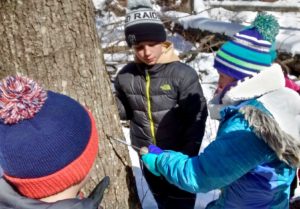Written by Mikayla Opichka, education intern

It is finally spring, which is a magical time of the year at Woodland Dunes. Birds are migrating back to our preserve as the days get warmer. During this time of year, the birds are not the only thing making great movement. Something deep within the trees in our forests has started its journey from the roots of the tree, all the way to its branches. What is this treasured substance that is active as the winter months’ transition to spring? Sap from maple trees!
It is in these few short months of early spring that it is prime time for sap to be collected from trees to make a delicacy. This natural treat, maple syrup, has been made for thousands of years and is still done by many people in our area. School groups have been able to attend a field trip to our preserve to learn about and collect sap from our maple trees during this vital time of year.
What is it about this time of the year that is so crucial to the process of collecting sap from maple trees? In preparation for the brutal cold months of winter, deciduous trees create excess sugar from water, carbon dioxide and sunlight through the process of photosynthesis. This occurs within their leaves before they fall to the ground during autumn. This sugar is deposited in the roots and sapwood so it can be used during spring to wake the tree back up with branch growth, buds, and leaves. As the weather outside gets warmer, the snow around the tree melts, providing water for the tree to start the sugar’s journey to the branches as sap.
The movement of sap is enhanced when temperatures are above freezing during the day, and below freezing at night. Under these conditions, cells within the inner bark expand and contract, helping to pump the sap upward. This occurs to a greater extent in maples than in other trees.
To collect the sap from the tree, a hole is drilled into the sapwood, and a spile, which resembles a spout, is placed into the hole to help the sap run out of the tree, then into a bucket or holding reservoir. The sap that comes out of maple trees tastes strikingly like water because it contains nearly 97.5% water, and only about 2% sugar. Maple sap is used to make syrup because this tree’s sap has one of the highest sugar concentrations compared to other kinds of trees.
There are a number of species of maples in our area- sugar, red, silver, mountain, and ash-leaved (more commonly known as boxelder), all of them have varying concentrations of sugar in their sap- sugar maple has the highest. At Woodland Dunes we have few sugar maples so tap red maples instead.
To turn the sap into maple syrup, it must be boiled to remove water and increase the sugar concentration. About forty-three gallons of sap must be boiled to make just one gallon of syrup! The next time you enjoy natural maple syrup, appreciate the incredible processes of nature that made this wonderful treat!
